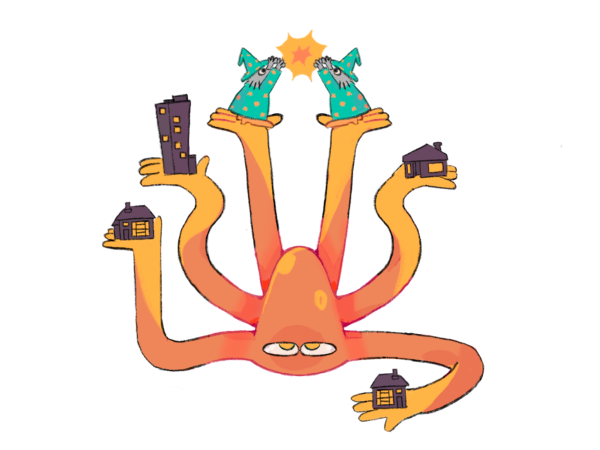The Regen Art Lab’s first residency programme brought together two of Regen’s experts and a visual artist who had no previous experience of working in the clean energy industry. The project set out to bridge the perceived gap between art and science to tackle the crucial but complex challenge of decarbonising the UK’s heat.
As the first ten weeks of the residency come to a close, the team reflect on their experience of collaborating across their disciplines. They detail their attempt to create an engaging and emotive communicative approach to share the issue with a wider audience. The exhibition of the artist’s final work will be launching in February 2022.
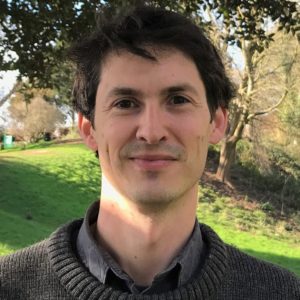


Mark Howard, Project Manager: Zero Carbon Heat and the Built Environment (Left); Sophie Whinney, Energy Analyst (Middle); Karenza Sparks, Visual Artist: Illustration and Animation (Right).
What did you think of the process?
Mark: Changing the way we heat our buildings, though technically achievable, is without doubt a tremendous challenge. Yet a possibly bigger challenge is getting landlords, tenants, and homeowners to support this change. Whilst it feels to me like public awareness of the issue is at a decade long high, it is hard for most people to really engage with what this might concretely mean for how they heat their home – a great communication challenge lies ahead.
Working with Karenza, an artist who came to this with no pre-conceived ideas about heat, has been refreshing and rewarding. I have enjoyed sharing my knowledge of the sector, challenging myself not to pass on too many of my own conclusions about what might be ‘best’, whilst also not giving unrealistic ideas about the limits of different solutions. For example, I was regularly forced to remind myself where the barriers to change were technical (there’s only so much biomass available to use as a fuel), political (gas is cheap and electricity is expensive), or psychological (most of us are reluctant to embrace change, particularly when it controls how we keep warm).
Sophie: Contributing to this collaborative project was a valuable learning experience for me; refining how I communicate and consider different methods of engaging the public with the scientific and socio-political concepts of decarbonising heat. I found particularly interesting and perhaps a bit surprising how quickly we were having deeply personal conversations around heat technologies in the sessions we ran with the wider team. I think this aspect, the intimate reality of people making their homes warmer spaces, is often underappreciated.
Karenza: For me, this project was primarily about communication, both in research and result, and making a little contribution to the dissemination of knowledge at large. I think there was some initial tension in my practice deciding how to navigate between a scientific and artistic approach to tackle the subject. It was a slightly daunting process of trying to clearly capture a large amount of technical information, whilst trying to honour the incredible care that I encountered by those trying to improve our heat system. This resulted in a new route altogether, which blended both the personal and the technical, the artistic and the scientific.
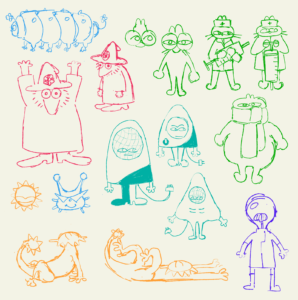

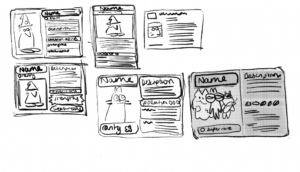
Sketches of characters representing technologies (Left); Bio Methane character figurine (Middle); Sketches of character card designs (Right).
What do you think of the outcome?
Karenza: During the course of this residency, I discovered a whole world which I never knew existed. It has been an incredible learning experience and privilege to have had access to Regen’s resources, to have their energy experts patiently explain very complicated systems to me, and to be able to speak with Community Energy members. In my conversations, I fluctuated between pessimism and optimism on the subject: on one hand continually discovering new challenges that exist in our current energy system, but on the other, finding out that there are countless people working hard to solve these problems and help each other.
Ultimately, this residency has made me want to collaborate and engage with more people outside of my known sphere, and has highlighted the incredible value in collaborating and communicating across disciplines and industries.
Sophie: It was no easy task for Karenza to work from scratch and to visually capture the dynamic and personal facet to a topic that is sometimes thought to be slightly dull. Yet, I think the rich learnings I got from our collaborative process and Karenza’s creation of personified heat technologies which ignite conversation show that it has been an important and successful exploration to pursue.
Mark: Through astute questions and active listening, Karenza mapped out new ways of thinking and engaging with decarbonising heat. The characters that she has created are for me a brilliant new take on technologies I would consider ‘old friends’, bringing them to life with personalities that ring true to their roles and capacities in our energy system. I am sure that this project will help enliven people’s interest in what can be a bit of a dry topic, and I hope, help them understand it even better.
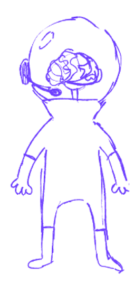
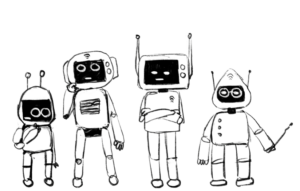
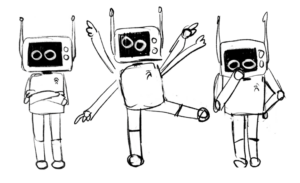

Sketches and progress of Digitisation character.
Read Karenza’s introductory blog here.
View her research process through her mind-map here, and view her research resources here.
You can follow Karenza’s making journey on Instagram here.

